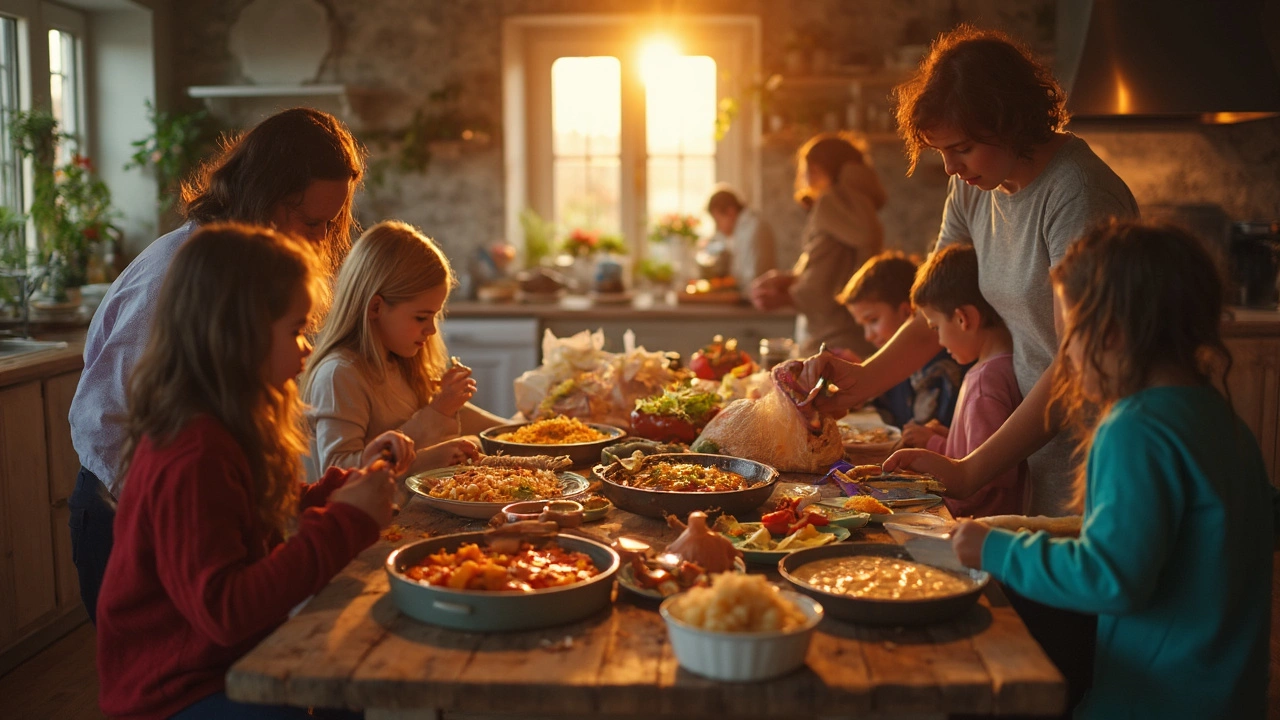Seven mouths to feed and a grocery bill that just won't quit? Trust me, you're not alone. Food prices keep climbing, and it can feel like your paycheck disappears before you even leave the store. The good news is, you don't need fancy recipes or expensive ingredients to keep everyone full and happy. The real trick is a mix of old-school meal planning, buying smart, and knowing how to make food stretch.
Sit down for a few minutes, check what’s already in your pantry and freezer, and plan a week’s worth of meals around that. Look for recipes with shared ingredients—think rice, beans, potatoes, pasta, and eggs. These basics turn into a lot of different meals, and they’re cheap even when you need to buy a ton.
A pro tip: Pick recipes without a huge shopping list. If a meal needs twenty different things, swap it out. The goal is quick, filling meals that don’t wreck your budget or take hours to cook. Bulk-cooking chili, soups, or casseroles means you get dinner and leftovers ready in one go, and no one leaves the table hungry.
- Smart Planning: The Key to Stretching Your Food Budget
- Bulk Buying: Saving Big Without Sacrificing Quality
- Cooking from Scratch: Simple Recipes That Fill Everyone Up
- Leftovers: Turning Yesterday’s Meal into Today’s Feast
- Snacks and Lunches: Keeping Kids Fed Without Breaking the Bank
- When Life Gets Busy: Shortcut Meals That Don’t Bust Your Budget
Smart Planning: The Key to Stretching Your Food Budget
Let’s talk strategy, not just shopping. Big families can crush the grocery game with old-fashioned meal planning and a little organization. Taking 20 minutes before you hit the store can save you serious cash. It’s not just about what you cook but how you plan.
The first step? Write down every meal for the week. Only plan realistic meals you know your crew will eat—don’t waste time (or money) on recipes that end up untouched. Try to double up on ingredients across meals. Using the same bag of carrots for soup, salad, and snacks means less waste and bigger savings.
Stick with budget-friendly staples. Rice, beans, pasta, potatoes, and eggs are all crowd-pleasers, super versatile, and usually on sale somewhere. If you have growing kids or teens, aim for meals that are filling, like casserole, stews, or baked dishes. These stretch the portions and build in natural leftovers for lunch the next day.
Check your fridge and pantry before writing your list. Most people already have plenty of forgotten food hiding in there, and building meals around what you have can shave $15-$30 off your bill each week.
- Plan meals that can be doubled—think chili, spaghetti, or stir-fry.
- Shop once a week and stick to your list. Quick "just one more thing" trips blow money fast.
- Look for store deals and digital coupons on items you actually use. Loyalty apps and store brands are a goldmine for savings.
If you like numbers, here’s a breakdown of typical budget meal cost for a big crew like yours, based on real US supermarket data from 2024:
| Meal Idea | Estimated Cost (7 people) |
|---|---|
| Potato & Egg Casserole | $8-10 |
| Bean Chili with Rice | $7-9 |
| Pasta with Homemade Sauce | $6-8 |
| Chicken Drumsticks & Roasted Veg | $12-14 |
Planning meals this way turns a grocery run from random spending into a game plan for cooking budget meals all week. It takes some effort upfront but totally pays off when you see how far your money goes.
Bulk Buying: Saving Big Without Sacrificing Quality
Buying in bulk sounds obvious, but people still underestimate just how much you can save. Stores like Costco, Sam’s Club, and even regular grocery stores with sales on family-size packs are your best friends when you’re working with a big family and a tight budget. Budget meals always start with thinking bigger — literally.
Focus on staple foods you know you'll actually use: rice, pasta, beans, oats, frozen veggies, and meat. When you buy 10 or 20-pound bags, the price per serving often drops by half or more compared to smaller packages. For example, a 10-lb bag of rice can cost less than $10 and last weeks in a big family. The same goes for dried beans or bulk packs of ground beef you can portion out and freeze. Check the unit price on the shelf tag (that small price per ounce or per pound listed under the big price); it's your secret weapon.
If you’ve got a little extra freezer space, use it. Buy family packs of chicken or ground turkey when they’re on sale, split them into smaller portions, and freeze what you won’t use right away. It’s also worth stocking up on frozen fruits and vegetables — they don’t spoil like fresh produce, and you usually get more for your buck.
Here’s a quick look at how buying in bulk really pays off:
| Item | Bulk Price (per lb) | Small Pack Price (per lb) | Approx. Savings |
|---|---|---|---|
| Rice (10 lbs) | $0.80 | $1.60 | 50% |
| Ground beef (5 lbs+) | $3.20 | $4.30 | 26% |
| Pasta (6 lbs) | $0.90 | $1.50 | 40% |
Don’t forget your pantry basics like canned tomatoes, beans, peanut butter, and oats. These might look pricey at first when you’re buying big cans or bags, but they stretch across a lot of family meal ideas — we’re talking chili, stews, breakfast bars, and more.
- Set a budget for your bulk items so you don’t overspend.
- Make a list before heading to the store so you stick with what you need.
- If you can’t use up everything before it goes bad, see if a friend or neighbor wants to split a big bag.
Bulk buying isn't about filling cupboards with trendy snacks. It's about getting more miles out of every dollar and making sure your meals don’t get repetitive or bland. Stick with the basics, buy what your family already likes, and watch those savings rack up.
Cooking from Scratch: Simple Recipes That Fill Everyone Up
Forget those overpriced meal kits and takeout. When you cook from scratch, you get way more food for your money—and you control what goes in your meals. With a budget meals mindset, a few basic skills, and the right cheap recipes, even a big family can eat well without breaking the bank.
Let’s talk staples first. Rice, pasta, beans, and potatoes are gold for families because they are cheap, filling, and super versatile. You can dress them up a hundred ways, and no one will get bored. Try these family meal ideas that keep both the fridge and bellies full:
- Big-batch chili: Brown some ground turkey or beef (or skip the meat and use more beans), add canned tomatoes, beans, some onion, and chili powder. Let it simmer—easy, cheap, and always a hit. Bonus: chili tastes even better the next day.
- Pasta bake: Cook up a couple pounds of pasta, toss in jarred sauce, canned veggies, and whatever leftover meat you’ve got. Top with shredded cheese and bake until bubbly. Feeds a crowd, no sweat.
- Sheet pan dinners: Chop potatoes, carrots, onions, and whatever protein is affordable (think chicken thighs or sausages). Toss with oil and seasonings, roast everything together. Easy clean-up, too.
- Bean and rice bowls: Cook up a big pot of rice and a pot of beans. Add whatever toppings you have—cheese, salsa, cooked veggies. It’s budget-friendly, and you can season it a million ways.
- Homemade soup: Leftover veggies and past-prime produce get new life in a big pot of soup. Add noodles or rice, throw in some beans or lentils, and season well. Serve with bread for a full meal.
The best thing? Most of these recipes cook up enough for lunch the next day or you can freeze extra portions for a future meal. Cooking from scratch takes a little more time up front, but it can save you hundreds every month.
Here’s a quick look at how the cost of scratch-cooked food compares to convenience foods for a typical large family meal:
| Meal Type | Cost per Serving (Homemade) | Cost per Serving (Store-bought/Takeout) |
|---|---|---|
| Chili | $0.85 | $3.50 |
| Pasta Bake | $1.00 | $3.00 |
| Soup | $0.75 | $2.50 |
You see the difference. With some planning and by leaning into cheap recipes that work for a crowd, those end-of-the-month grocery dollars stretch a lot further.

Leftovers: Turning Yesterday’s Meal into Today’s Feast
Leftovers get a bad rap, but they’re a budget meal lifesaver, especially for big families. Why cook from scratch every night when you can give yesterday’s dinner a fresh spin? Reworking leftovers not only cuts food waste but also saves serious time and cash.
Start by planning meals that will naturally leave you with ingredients or portions you can easily reuse. For example, roast a whole chicken and use the meat for tacos, chicken salad, or soup later in the week. If you’ve got leftover rice, don’t just reheat it—use it in fried rice, burritos, or stuff it into peppers. Transforming food this way keeps meals interesting so nobody groans, “This again?”
- Chili or stew: Scoop it over baked potatoes, roll it into tortillas for burritos, or top with some cheese and bake for a new casserole.
- Pasta: Turn leftover spaghetti into a pasta bake or “spaghetti pie” with eggs and cheese.
- Cooked vegetables: Add them to omelets, throw them into soups, or blend into sauces for picky eaters.
- Leftover bread: Cube for croutons, breakfast casseroles, or even homemade breadcrumbs.
A quick tip: Label everything with the date before sticking it in the fridge. Otherwise, mystery containers take over fast. And don’t be afraid to freeze extras—most things like chili, baked pasta, cooked beans, and pulled meats freeze and reheat like a dream.
Did you know? Feeding America says that U.S. families toss out about $1,500 of food every year, mainly from forgotten leftovers. If you’re really counting pennies, building a system around family meal ideas that use up every bite can put money back in your pocket.
| Popular Leftover Makeover | What to Do |
|---|---|
| Leftover chicken | Quesadillas, fried rice, chicken noodle soup |
| Mashed potatoes | Potato cakes, shepherd’s pie, added to bread dough |
| Rice | Stir-fry, rice pudding, stuffed peppers |
With a little creativity, budget meals become less boring. You end up with new dishes everyone actually wants to eat, all while keeping your wallet happy.
Snacks and Lunches: Keeping Kids Fed Without Breaking the Bank
The after-school rumble is real—everybody’s hungry, but buying chips and snack packs for a family of seven gets expensive fast. Instead, focus on simple, homemade snack ideas that stretch your food budget while actually filling kids up. The secret? Rely on basic ingredients you probably already have in your fridge or pantry.
For portable and cheap snacks, you really can’t beat popcorn. Buy a big bag of kernels and pop them yourself; it’s pennies per serving and you can add anything from cinnamon sugar to a sprinkle of cheese powder. Similarly, apples and carrots are often the lowest price per pound in the produce section. Peel and cut a few up for grab-and-go snacks. Hard-boiled eggs work too—they’re protein-packed and way cheaper per serving than snack bars.
- Family meal ideas don’t have to be complicated: batch up peanut butter and jelly sandwiches (on sale bread works great), store them in the fridge, and the kids can just grab them for lunch.
- DIY yogurt parfaits: Buy large tubs of plain yogurt, sweeten it with a bit of honey, and add whatever fruit is in season or frozen. A sprinkle of oats or homemade granola on top goes a long way.
- Bean and cheese quesadillas: Tortillas are usually cheap when bought in bulk, and you only need a little cheese and a spread of canned refried beans. They reheat well and fill everybody up.
- Homemade trail mix: Instead of pricey pre-made mixes, combine store-brand cereal, pretzels, raisins, and a handful of chocolate chips or nuts (when those are on sale).
If you’ve got more time, make a big batch of hummus with canned chickpeas, olive oil, lemon juice, and garlic. It costs less than store-bought tubs and pairs with carrots, celery, or pita bread for a healthy snack.
| Snack | Average Cost (for 7 servings) |
|---|---|
| Homemade Popcorn | $0.70 |
| Carrot Sticks with Hummus | $2.10 |
| Egg Salad Sandwiches | $3.50 |
| Peanut Butter & Jelly Sandwiches | $2.80 |
| DIY Yogurt Parfaits | $4.20 |
It’s easy to get stuck in a rut with lunches, so switch up sandwiches with pasta salad or quesadillas. Leftover rice tossed with veggies and a fried egg is a strong option, too. If your family is like mine, variety keeps everyone happier. Chasing sales and being willing to swap out one snack for another can save real money over a month.
When Life Gets Busy: Shortcut Meals That Don’t Bust Your Budget
No one has time to cook from scratch every single night, especially in a big family. After a long day of work, homework, and running around, you need meals that are fast and easy on the wallet. That’s where smart shortcut meals save the day. You don’t need to hit the drive-thru—you just need a few go-to ideas up your sleeve.
First, lean into budget meals that come together with minimal prep. Rotisserie chicken from the store is a lifesaver—shred it up for tacos, toss it in pasta, or make quick chicken sandwiches. Most stores sell them for less than buying a raw chicken and take the stress out of dinner.
Canned beans, store-brand frozen veggies, and instant rice are solid gold for putting together cheap, filling family meal ideas. Throw them all in a big pan with salsa and some spices, and everyone’s eating in fifteen minutes. Or load up a baking sheet with potatoes, veggie scraps, and sliced sausages—sheet pan dinners are simple and almost impossible to mess up.
- Pasta night is always a winner. Cook up a couple boxes of spaghetti, add jarred tomato sauce, and maybe some frozen meatballs. Garlic bread from day-old rolls rounds it out.
- Quesadillas with cheese and anything leftover work for lunch or dinner. Beans, cooked veggies, pulled chicken, even scrambled eggs—just stuff, press, and grill.
- Big batch scrambled eggs and toast with fruit is a hit when you’re running late or totally spent. Eggs are loaded with protein and cheap for how many mouths they feed.
Don’t forget the power of simple swaps—buying pre-shredded cheese or bagged salads might cost a little more, but they still save compared to takeout or convenience freezer meals. If you shop sales and buy bigger bags, you’ll cut costs even more.
Here’s a quick look at what a family of 7 could spend on these types of shortcut cheap recipes in April 2025 prices:
| Meal | Key Ingredients | Approx. Total Cost |
|---|---|---|
| Rotisserie Chicken Tacos | Rotisserie chicken, tortillas, lettuce, salsa | $14 |
| Sheet Pan Sausage & Veggies | Sausage, potatoes, frozen veggies | $11 |
| Pasta Night | Spaghetti, jarred sauce, garlic bread | $10 |
| Quesadillas | Tortillas, cheese, beans | $8 |
| Eggs & Toast | Eggs, bread, fruit | $9 |
Feeding a big family doesn’t have to mean slaving in the kitchen or blowing your budget. With a few trusted shortcut meals, you’ll save money and keep everyone happy when life gets hectic.





